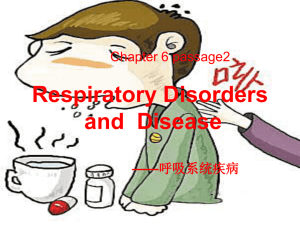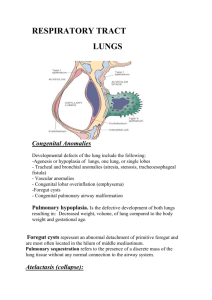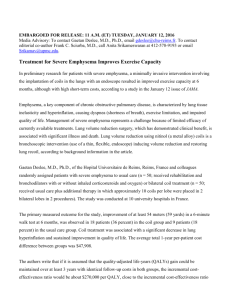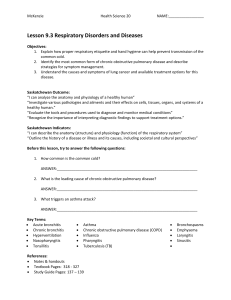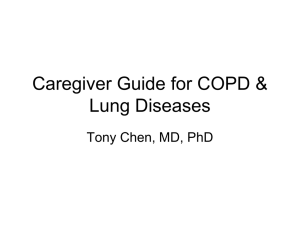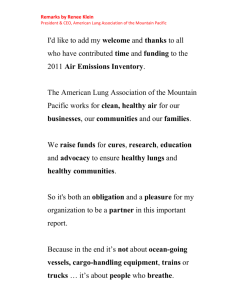Restrictive lung disease
advertisement
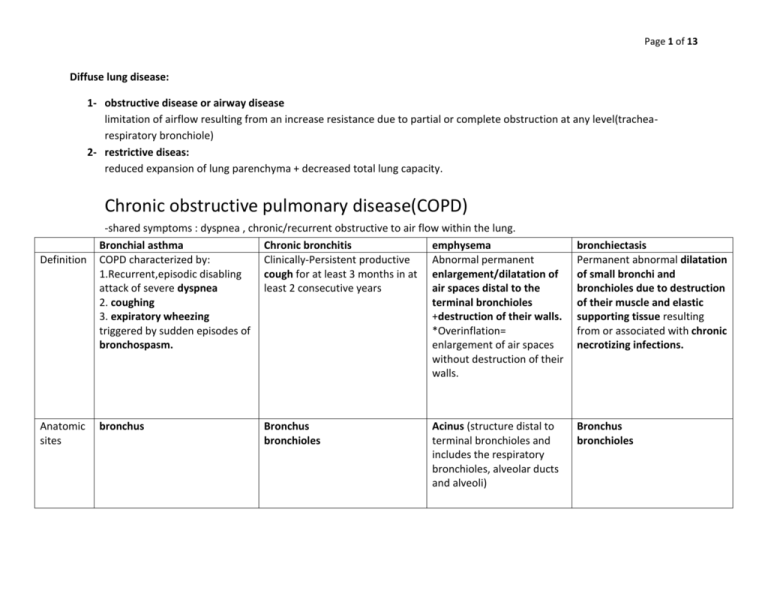
Page 1 of 13 Diffuse lung disease: 1- obstructive disease or airway disease limitation of airflow resulting from an increase resistance due to partial or complete obstruction at any level(trachearespiratory bronchiole) 2- restrictive diseas: reduced expansion of lung parenchyma + decreased total lung capacity. Chronic obstructive pulmonary disease(COPD) Definition Anatomic sites -shared symptoms : dyspnea , chronic/recurrent obstructive to air flow within the lung. Bronchial asthma Chronic bronchitis emphysema COPD characterized by: Clinically-Persistent productive Abnormal permanent 1.Recurrent,episodic disabling cough for at least 3 months in at enlargement/dilatation of attack of severe dyspnea least 2 consecutive years air spaces distal to the 2. coughing terminal bronchioles 3. expiratory wheezing +destruction of their walls. triggered by sudden episodes of *Overinflation= bronchospasm. enlargement of air spaces without destruction of their walls. bronchus Bronchus bronchioles Acinus (structure distal to terminal bronchioles and includes the respiratory bronchioles, alveolar ducts and alveoli) bronchiectasis Permanent abnormal dilatation of small bronchi and bronchioles due to destruction of their muscle and elastic supporting tissue resulting from or associated with chronic necrotizing infections. Bronchus bronchioles Page 2 of 13 Etiology/ pathogen esis Bronchial asthma Chronic bronchitis 1.atopy-genetic predisposition to mast cell igE type1 hypersensitivity reaction 1. chronic irritation by inhaled substances. (*cigarrete smoking -SO2, N02) >Stimulates hypersecretion of mucus, > hypertrophy of mucous glands in trachea and bronchi, >bronchioles goblet cells metaplasia, bronchiolitis “small airway disease” 2. acute & chronic airway inflammation 3. bronchial hyperresponsiveness to any irritants. emphysema A. centriacinar and panacinar emphysema Destruction of alveolar wall is primary event. Theory: protease antiprotease mechanism -imbalance between proteases (elastase) and anti proteases(a1 anti trpsin) in lung=> proteolytic destruction of elastic tissue=>emphysema. Eg: 2. microbiologic infection. 1.smokers >maintaining inflammation and Smoke particles in small may cause acute exacerbation. bronchi and bronchioles: > stimulate neutrophils and Net result of excessive mucous macrophages proteolytic secretion and infection: activity in lung. -accumulation of mucopurelent >inhibit a1 antitrypsin discharge in lumen of bronchi activity ending in and bronchioles. And destruction of proximal part -bronchiolitis , destruction of of acinus and development their walls ending in fibrosis. This of centriacinar emphysema. will lead to airway obstruction. 2. a1 antitrypsin deficiency=>unchecked elastic tissue destruction by elastase enzyme=>panacinar emphysema. Bronchiectasis Predisposing factors: 1. Bronchial obstruction(tumour, foreign body, impacted mucus, chronic bronchitis or atopic asthma). 2. hereditary or congenital conditions(cystic fibrosis of lung, ig deficiency, structural abnormality of cilia such as in immotile cilia syndrome) 3. necrotizing or suppurative pneumonia. Pathogenesis: In presence of 1.obstruction and 2. chronic persistence infection. Either of them may come 1st. 1.obstruction=>air resorbedfrom airways distal to the obstruction=>atelectasis in alveoli, elastic forces within the lobe disappear=>relaxation and dilatation of those airways that are patent. Clearing mechanism is impaired in these dilated airways=>2ndry infection. Page 3 of 13 B. irregular and distal acinar 2ndry to fibrosis of adjacent lung parenchyma. How? 1. scarring and fibrosis resulting from healing of granulamatous lesion(tb,sarcoidosis)=>incr ease elastic pull of adjacent alveoli=>destruction of their walls. 2. fibrosis=>distortion of bronchial and bronchiolar walls=>narrowing esp in expiration=>air trapped in alveoli=>further destruction of their walls. So, bronchial narrowing acts as “one way valve”(permitting entrance of air in alveoli during inspiration and preventing its exit during expiration). 2. infection=> -bronchial wall inflammation and weakening leading to increse its dilatation. -may cause extensive bronchiolar damage=>endobronchiolar obliteration=> atelactasis distal to obliteration+ bronchiectatic dilatation around atelactatic area. Page 4 of 13 Types Gross Bronchial asthma 1~pathophysiology of asthma: -extrinsic -intrinsic -mixed patterns Chronic bronchitis ~clinically: 1. simple chronic bronchitis 2. chronic mucopurulent bronchitis 3. chronic asthmatic bronchitis 4. chronic obstructive bronchitis 2~agents/events that trigger bronchospasm: -seasonal -Exercise induced -drug induced : aspirin-sensitive asthma -occupational:triggered by fumes,organic and chemical dust , gases and other chemicals -asthmatic bronchitis in smokers -Lungs are: voluminous due to -Mucous membrane of larger everinflation and air trapping. airways is swollen , edematous , -Fill entire chest wall hyperaemic and covered by mucinous,mucopurelent or Small and medium sized purelent secretions. bronchi: -Occluded with thick , tough , -Smaller bronchi and bronchioles tenacious mucus plugs formad filled with same secretions. of whorls of shed epithelium(curschmann spirals) and charcot leyden crystals emphysema Bronchiectasis ~anatomic distribution in acinus: 1 .centriacinar (entrilobular) emphysema 2. panacinar (panlobular) emphysema 3.distal acinar (periacinar , paraseptal , superficial) emphysema 4. irregular emphysema Other types: -compensatory emphysema -senile emphysema -intersitial emphysema. Depends on types and severity. 1.panacinar Lungs-voluminous, overlapping the heart and hiding it. Pulmonary tissuehypercrepitant(+++ air) Emphysematous lobes-pale due to compression of blood vessels. 2. centriacinar Macroscopic feature not evident unless condition is -May be Bilateral , unilateral , or segmental. -Usually affect lower lobes -Small bronchi and bronchioles dilated(4× its normal sizes) and can be traced to the pleural surface. -Dilatation- saccular, fusiform ,cylindroids , or cystic with honey comb appearance. -Lumen of dilated part filled with suppurative, yellowish green to hemorrhagic Page 5 of 13 severe and advanced. Upper 2/3 of lung more affected. Microsco pic 1.Bronchi and bronchioles obliterated by mucus plug+whorls of shed epithelium(curschmann spirals) 1. Chronic inflammation of airways with cellular infiltrate predominantly lymphocytes. 3. irregular and distal *Presence of large apical bullae: -Subpleural -Cyst like spaces -Wall-thin and formed of fibrous tissue. -Contents-air -Naked eye-translucent 1.Overdistension of alveoli. exudates. -Removal of exudates reveal an edematous reddish green or necrotic black ulcerated mucosa. squamous metaplasia can be seen. 1. Lining epitheliumdesquamation , ulceration , or squamous metaplasia. 2.Complete destruction of septal wall leaving only a 2. enlargement of mucous strand of residual tissue 2. Lumen-obliterated with 2.Numerous eosinophils-charcot secreting glands of trachea and with mucopurulent exudates. leyden crystals(made of protein large bronchi. Very small compressed of eosinophil membrane ) Reid index(ratio of mucous gland blood vessels appear as free 3. Wall- inflamed. layer to the thickness of wall floating island of tissue. 3.Airway remodeling: between epithelium and 4. in more chronic cases-thickening of basement cartilage) normally 0.4 but it 3. Respiratory bronchioleshealing by fibrosis occurs, membrane of bronchial increase in chronic bronchitis. distorted, evidence of associated with peribronchial epithelium. bronchitis and bronchiolitis fibrosis and atelactasis. -edema and inflammatory 3. slight increase in goblet cells + may be present. infiltrate(eosinophils, mast cells) loss of ciliated epithelial cells. 5. Severe cases-necrotizing -Increase size of submucosal Squamous metaplasia occurs and reaction destroys the walls and mucous glands. ay be followed by dysplasia. forms lung abscess. -Hypertrophy of bronchial wall Page 6 of 13 smooth muscle cells. Clinical features -Attacks of dyspnea, -Cough, -Wheezing(a soft whistling sound during expiration) -Attacks are triggered by sudden episode of bronchospasm -Usually relieve spontaneously or with treatment(bronchodilators, costicosteroids) -In between attacks-patients free from respiratory difficulty but occasionally attacks are severe, fail to respond to therapy, persist for days or weeks(“status asmathicus”) 4. chronoic bronchiolitis- goblet cells metaplasia, inflammation, fibrosis of wall, smooth muscle hypertrophy, marked narrowing of lumen and in severe cases completely obliteration of lumen. 5.hypersecretion 1.Simple chronic bronchitis -Productive cough(mucous in nature) , air flow not obstructed 2.Chronic mucopurulent bronchitis -Chronic cough+mucopurulent sputum 3.Chronic asthmatic bronchitis -Chronic cough , productive sputum, intermittent episodes of bronchial asthma. 4.Chronic obstructive bronchitis Marked outflow obstruction. -Dyspnea and chronic cough=>barrel shaped chest. -Dyspnea and orthopnea in severe cases. -Cough with foul odour sputum Hypoxaemia=>polycythemia esp in morning. . -Fever -Clubbing of fingers -Chronic -Lung abscess , gangrene of hypoxaemia=>pulmonary lung, sometimes associated vascular spasm, pulmonary with hemoptysis(destruction of hypertension and cor blood vessesl) pulmonale. -Emphysema, bronchopleural fistula, and pyopneumothorax. -Rupture of -Metastatic brain abscess and bullae=>pneumothorax=> meningitis. colllapse of lung. -Squamous metaplasia=>sq cell carcinoma. -Amyloidosis( increase proteinatious material in intersitial spaces). -Rarely cor pulmonale. Page 7 of 13 Incidence Bronchial asthma Chronic bronchitis emphysema 5% adults 7-10% children Most frequent- middle aged men Ventillatory disability- 5th esp in heavy smokers decade of life but with air pollution it occurs earlier. Males>females. Esp heavy smokers. Bronchiectasis Rarely primary disease of lung but it develops as sequel to: -persistent infection of lung -or to previous obstructive airway disease. All ages and both sexes. Genetic and familial incidence. complicati 1.Superadded ons infection=>chronic bronchitis, bronchiectasis, bronchopneumonia. 1. Precanacerous conditions(squamous metaplasia and dysplasia)=>bronchogenic carcinoma. 2.obstruction=>emphysema,atel 2. emphysema in areas with actasis incomplete obstruction. 3. cor pulmonale 3. atelactasis in the areas where obstruction is complete. 4. right side heart failure, cor pulmonale. 5. death due to: -recurrent bacterial infection -respiratory failure -right side heart failure. 1.Same to clinical pictures above. 2. die due to: -pulmonary failure with respiratory acidosis -hypoxia -coma -right side heart failure Same as clinical features above. Page 8 of 13 Types of emphysema Affected part Incidence Associated with Centriacinar (centilobular) Proximal or central parts of acini(respiratory bronchioles), Distal parts not affected. Upper lobes particularly apical segments Males esp heavy smokers. Chronic bronchitis Panacinar (panlobular) Acini uniformly dilated from terminal bronchioles to terminal blind alveolar spaces. Affects lower zones , anterior margins of lungs and most severe in bases of lobes. -Distal part is dominantly enlarged and destroyed. -proximal part is normal. -Occurs adjacent to pleura and at margins of lobules along connective tissue septa and adjacent to areas of fibrosis, scarring , or atelactasis. Acinus irregularly involved Distal acinar (periacinar, paraseptal, superficial) Irregular Walls of emphymatous spaces -Contain large amount of pigmented alveolar macrophages. -Inflammation is common around bronchi and bronchioles and in septa A1 antitrypsin deficiency Most common Scarring of lung. Eg: tb, sarcoidosis. Asymptomatic in most cases. Page 9 of 13 Restrictive lung disease Definition: group of disease identified by a reduced total lung capacity while expiratory flow rate is normal or slightly reduced. May be due to: 1. extrapulmonary chest wall disorders, lungs are normal. Eg: poliomyelitis, obesity, scoliosis, kyphosis etc. 2. parenchymal causes(lung itself). Parenchymal restrictive lung diseases *acute restrictive lung disease *chronic interstitial (restrictive ) lung disease There is: reduction in o2 diffusion capacity, lung compliance, and lung volume. acute Eg: ARDS-Acute respiratory distress syndrome(diffuse alveolar damage) types - Causes Infection,Physical injury, Inhaled irritants,Chemical injury,Trauma. chronic Definition: heterogenous group of disorders characterized by diffuse and usually chronic involvement of pulmonary connective tissue in intersitium of alveolar walls. They have similar clinical signs, symptoms, radiologic alterations, pathologic changes. ~characteristic histologic features: 1.fibrosing 2.granulamatous –pneumoconiosis 3. eosinophilic 4. Smoking related Page 10 of 13 pathogenesis More than 50% of ARDS associated with: Sepsis, diffuse pulmonary infection, gastric aspiration ,trauma including head injury. Primary lesion: -diffuse damage of endothelial cells of capillary, Epithelial cells of alveoli. Injury is mediated by neutrophils and macrophages. morphology Earliest common manifestation is alveolitis( interstitial pneumonitis) characterized by accumulation of inflammatory cells and immune effector cells in alveolar wall and intersitium. Release of chemical mediators lead to: -injury of endothelial cells of capillaries and flat epithelial cells of alveoli -stimulates fibrosis. Final result: end stage fibrotic lung aka “stiff lung”: -alveoli replaced by cystic spaces separated by thick bands of connective tissue containing inflammatory cells “honey comb lung” -function of alveolocapillary membrane is lost. Consistent feature of all cases irrespective to causative agents is diffuse alveolar damage. Microscopically: distended alveolar ducts lined with a hyaline membrane (protein rich fluid exudates + remnants of necrotic epithelial cells. Clinical features and complications fate Dyspnea, tachypnea, cyanosis without wheezing or any evidence of airway obstruction. x-ray- diffuse infiltration by small nodules , irregular lines “ground glass shadow” Severe hypoxia , respiratory failure associated with pulmonary hypertension , cor pulmonale(right side heart failure) Page 11 of 13 Pneumoconiosis Due to anthracosis silicosis asbestosis berylliosis Carbon deposition in lung. -Coal miners disease Prolonged inhalation of silica =>scattered interstitial pneumonitis=>fibrosis and formation of grayish black silicotic nodules Prolonged heavy exposure to asbestos. *also lead to bronchogenic carcinoma of lung, mesothelioma of pleura, carcinoma of larynx. Low dose exposure to beryllium for many years=>non caseating granulmatous lesions.=>heal by fibrosis(xray: fine nodular densities) Hypersensitivity pneomonitis Hypersensitivity to inhaled ag in form of organic dust. -non caseating granulama Page 12 of 13 BRONCHIAL ASTHMA Initiated by Triggered by incidence severity Extrinsic (allergic ,atopic) bronchial asthma. Ig e type 1 hypersensitivity reaction(atopy) exposure to extrinsic antigen Eg: environmental ag(pollens, animal dander, dusts, foods etc) -50% of cases of asthma is exrtinsic -Starts in children and young adults -Most of patients have family history Less severe and easily managed. Attacks diminish in later years Drug No drug hypersensitivity hypersensitivity Signs and Asthmatic attacks are often symptoms preceded by allergic rhinitis, urticaria, or eczema Serum ig e levels are raised in about 60% patients complications Rarely: -development of chronic bronchitis. -emphysema Intrinsic(non allergic, non atopic) bronchial asthma Diverse non immune mechanisms Ingestion of aspirin, Respiratory tract infection esp viral , cold, inhaled irritants, stress and exercise. (inflammation causes hyperirritability of bronchial tree through abnormal autonomic regulation). Starts in adult life. No family history Attacks increase in severity with passage of time. May develop(aspirin,penicillin) No other associated allergy. Serum ig e levels-normal. Commonly: -development of chronic bronchitis -Emphysema. Mixed pattern Both extrinsic and intrinsic factors operate together. Page 13 of 13 Rebutlah 5 perkara sebelum dating 5 perkara: 1. 2. 3. 4. 5. Masa muda sebelum tua Masa Sihat sebelum sakit Masa Kaya sebelum miskin Masa Lapang sebelum sibuk Masa hidup sebelum MATI.

